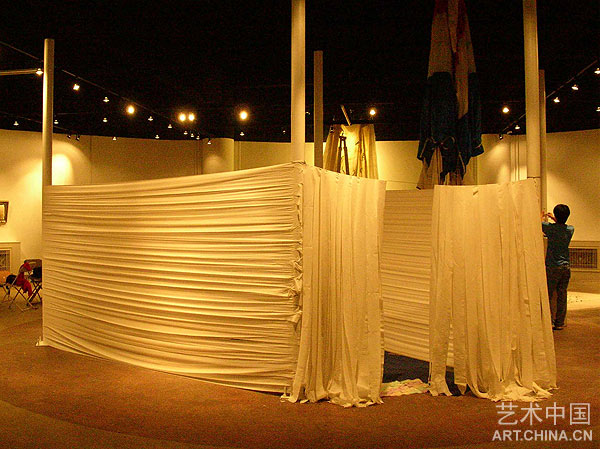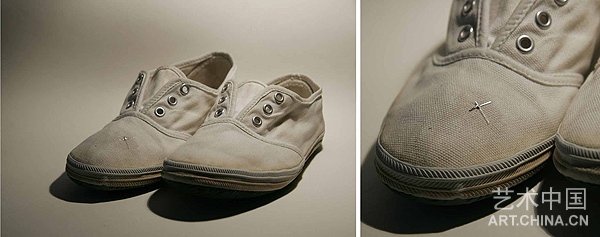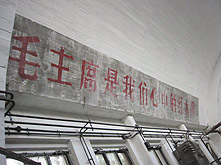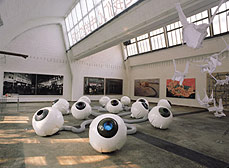|
玩画廊/ IS IT OK TO HAVE FUN IN AN ART GALLERY?


2007.2.10- 2007.3.18
展览招待会: 2月 10 日 15:00-18:00
16:00~ 音乐演出:孟奇,音色时代文化传媒有限公司

www.muzicolor.com
OPENING RECEPTION:
10th Feb 3-6pm
From 4pm~ Live Music Performance by MengQi,
Muzicolor Entertainment Co., Ltd
www.muzicolor.com
Participant artists
柏鸣 Bai Ming
冯琳 Fenglin
胡艳兰 Hu YanLan
金钕 Jin Nu
梁桃 Liang Tao
梁远苇 Liang Yuanwei
唐钰涵 Tang YuHan
王田田 Wang Tiantian
夏鹏 Xia Peng
张一 Zhang Yi
策展人/Curators
白雪 |冯博一
Snejana Krasteva and Feng Boyi
主办/Organizer
Concept 展览简介
在最近几年里,中国现代艺术圈里发生了许多变化。我们目睹了各种各样的潮流兴起,目睹了不计其数的艺术家涌现。这颗“ 东方之星”的能量让向来有自我中心倾向的西方艺术界屡屡惊叹神迷。生活在这样的环境中,我们不禁发出这样的疑问:在这一切的背后到底是什么样的力量在起作用?
潮涨潮退自有时;艺术家能拔萃而出,原因在于其内心的能量与其创作的才华,但是许多人相信并且支持他们的见解,也是必不可少的 因素。从一开始,中国的现代艺术界就注定是独特而强劲的一股力量。它脱胎而出的那个特殊的历史境遇激发了那些富于叛逆精神的个体,让他们敢于挑战,首先挑战自己,然后挑战他们周围的世界。在最初阶段,并不存在任何可以帮助这些艺术家的机构;没有任何画廊,也很少有人敢于公开表示欣赏他们的艺术。这些艺术家是孤军奋战的。仅仅过了20年,关于当代艺术的中外画廊,博物馆,基金会便数以千计了。每一个月都会有十多个展览开幕,轮番“ 轰炸”这个国家;每一个展会都野心勃勃,期望能有所作为,推陈出新,在中国艺术史上留下长久的印记。就这一点来说,这些展览成功与否倒在其次,更重要的是举办展览本身这个事实。每一个展览都是一次契机,让一些人能实现创作,让一些人能展开批评,还让不计其数的人能借此去看,去学,去用一种新的方式思考这个世界。
“ 玩画廊/ IS IT OK TO HAVE FUN IN AN ART GALLERY”这个题目就是要在中国现代艺术的背景上引起人们对一个画廊在互相勾连的艺术世界里所扮演的角色的注意。在考虑什么适合展出时,画廊的商业性质常常导致了一定程度的严肃。展览在“ 商业化”和“ 纯”艺术内容之间谋求平衡的做法也常常遭致批评。那么,一个画廊有没有可能通过展览中的实验,通过展示新的年轻艺术家,通过为年轻艺术家提供一个游戏场所,开掘他们的潜力,来做到仅仅“ 供人一乐”而将其它计较置之脑后呢?
北京东京艺术工程是最早进驻北京798艺术区的画廊,从进驻之日起它就致力于举办挑战性的展览,其挑战不断升级。即将开办的这一次展览将是一个新的契机,让人们重新检验它的这个角色,而且,同样重要的是,与我们的艺术家一起玩一次画廊。
玩一玩,可以吗?

TangYuHan

JinNu-1

LiangYuanWei
In recent years many changes have occurred in the Chinese art scene. We have seen the rise of various trends and the emergence of numerous artists. The egocentric Western art world remains astonished and fascinated by the power of this “Oriental Star”. Living in such a context we cannot help but ask ourselves, what force is behind all this?
Trends rise and fall; artists shine because of the inner force and genius in their creations, but also because many people believe and support their visions. From the beginning, the Chinese art scene was destined to be a unique and powerful force. The specific historical context in which it originated compelled rebel-minded individuals to dare to challenge first themselves and then the world around them. In the early years no institutions existed to help these artists; there were no galleries, there were few people daring enough to openly appreciate their art. The artists struggled alone. Just 20 later, hundreds of foreign and local contemporary art galleries, museums, and foundations exist. Every month a dozen exhibition openings “strike” the country; each exhibition aspiring to make a point and outdo the past and leave a lasting imprint upon Chinese art history. At this point, whether or not they succeed is less important than the fact that they are being held. Every exhibition provides an opportunity for someone to create, for another to criticize, and for countless others to watch, learn, and think about the world in a different way.
“IS IT OK TO HAVE FUN IN AN ART GALLERY” is a title that seeks, against the background of Chinese art, to draw attention to the role an art gallery has in the interconnected art universe. The commercial nature of galleries often engenders a certain degree of seriousness over what is suitable for exibition. Exhibitions are often criticized based on the balance they strike between the “commercial” and the “pure” art contents they contain. Through experimentation in the exhibition, by presenting new young artists and giving them a playground to explore their capabilties, can a gallery just “enjoy” and get away with it?
BTAP has been the first gallery inhabiting the 798 art disctrict in Beijing, and ever since has tried to present more and more challenging exhibitions. This upcoming exhibition is another opportunity to re-examine that role and, not at the last place – to have fun with our artists. Is it OK?

Beijing's Dashanzi Art District is only four years old, but it is known the world over. The transformation of this state-owned industrial area into the heart of China's booming art market began when Beijing Tokyo Art Projects (B.T.A.P.) established itself there first in October 2002.

Having closely followed the development of Chinese contemporary art since the late 1980s, Yukihito Tabata set up the gallery with the intention of bringing artists from China, Japan and Korea together and introducing them to a wider audience. B.T.A.P.'s establishment came at the moment that Chinese contemporary art became the zeitgeist of the East Asian art scene and was the impetus for dozens of galleries from around the world moving into the Dashanzi area in the years since.

The impressive exhibition space is flooded with natural light that comes in through the large, arched skylights of this 400 meter-square, former munitions factory: the defining architectural signature of this East German-built Bauhaus-style building. The walls are white but still rough and just underneath the skylights, a communist slogan that urges the workers to feel Chairman Mao's spirit as the red sun in their hearts still remains painted on the wall. Recently, MAD architectural studio made a sleek redesign of the gallery's entrance hall that not only tripled the office space but added more exhibition space in the form of a mezzanine floor.

B.T.A.P. has held a consistently exciting and experimental program of exhibitions that showcase the work of both established and up-and-coming artists working in all media. Techno-Orientalism brought together some of Asia's finest new media artists to present works that investigate the balance between advanced technology and popularized notions of traditional Asian aesthetic sensibilities. Movement, Feeling, Environment was a solo show of work by Nobuo Sekine, one of the key figures in the pivotal Japanese postwar art group Mono-ha and the exhibition was the first of its kind to introduce Sekine's work to a Chinese audience. In his solo exhibition Waste Not, Song Dong explored his relationship with his mother and the meaning of family heirlooms against the backdrop of China's increasingly materialistic, capitalist society.
As Chinese society continues to change at such a rapid pace, so too does its artistic expression. Set in a unique location that juxtaposes the legacy of the past with the vigour of the present, B.T.A.P. continues to be the ideal venue to keep up with those changes.
|

